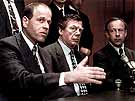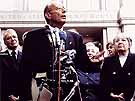
|
|
|

|

|

|

|
|
Click on an image to see a larger, more detailed picture.
|
|
|
|
|
| EPILOGUE: The Aftermath |

|
pg. 690 |

|
|
|
|
| |
|
When 20 trips to Credit Suisse from Paris from 1946 to 1957 accomplished nothing, she gave up her quest, left Europe for New York in 1969, and took up residence in a one-room apartment in Queens. She never married and spent 27 years working in a drug store before she retired. Then Sapir heard a news report.
|
 At a May 1996 news conference in New York City, Avraham Burg (left), chairman of the Jewish Agency, announces a landmark agreement with the Swiss Banking Association to investigate dormant assets deposited decades ago by Holocaust victims.
At a May 1996 news conference in New York City, Avraham Burg (left), chairman of the Jewish Agency, announces a landmark agreement with the Swiss Banking Association to investigate dormant assets deposited decades ago by Holocaust victims.
Photo: AP Photo / Richard Drew
|
|
Early in 1996, at the urging of the World Jewish Congress, U.S. Senator Alfonse D'Amato, head of the U.S. Senate's banking committee at the time, was launching an inquiry about the billions of dollars in accounts that Jews had established for safekeeping in Swiss banks. Sapir contacted D'Amato. After telling him her story the next day, she became the lead plaintiff in a class-action suit to require Swiss banks to restore--with rightful interest--Jewish assets to their owners or heirs. In May 1998 Sapir became the first Holocaust survivor to receive a settlement from a Swiss bank. When Credit Suisse made the payment--reported to be between $300,000 and $500,000--its press announcement from Zurich stated that the bank had done so after extensive research showed that Josef Sapir did indeed have prewar business links to Credit Suisse. By August 1998 Credit Suisse and UBS, another major Swiss bank, announced that funds totaling $1.25 billion would be available for other settlements. As for Estelle Sapir, her comment to the press was, "It's not about money. It's about justice." Less than a year later, Sapir, the lone surviving member of her family, was dead.
|
 In August 1998 Senator Alfonse D'Amato of New York announced that the Italian insurance company Generali had agreed to pay $100 million to Holocaust survivors and victims' heirs.
In August 1998 Senator Alfonse D'Amato of New York announced that the Italian insurance company Generali had agreed to pay $100 million to Holocaust survivors and victims' heirs.
Photo: Reuters/Mike Segar/Archive Photos
|
|
The Holocaust continues to defeat justice. Money provides tangible compensation, but there is no recompense for the Final Solution, even if Germany has already paid tens of billions of dollars in reparations and aid to Jewish groups, the state of Israel, and Holocaust victims. The irreplaceable cannot be replaced, even if 16 German companies announce, as they did in 1999, that they have created a fund of $1.7 billion to compensate former slave laborers, Jewish and non-Jewish, whose work during the Nazi period served those companies and benefited the Third Reich's genocidal policies. Those German companies include DaimlerChrysler, Deutsche Bank, Siemens, Volkswagen, Hoechst, Dresdner Bank, Krupp, Allianz, BASF, Bayer, BMW, and Degussa.
|
|

|

|

|

|
 December 16, 1996: U.S., British, and French officials agree to halt distribution of $68 million in Nazi gold bars--much of it made from gold stolen from Jews (gold rings, watches, and dental work)--that have been stored in the vaults of the Federal Reserve Bank in New York City and in the Bank of England.
December 16, 1996: U.S., British, and French officials agree to halt distribution of $68 million in Nazi gold bars--much of it made from gold stolen from Jews (gold rings, watches, and dental work)--that have been stored in the vaults of the Federal Reserve Bank in New York City and in the Bank of England.
|
 December 16, 1996: French art historians investigate claims that fine art looted by Germans from Jews and other owners is hanging in the Louvre and other French museums. Many U.S. fine-arts museums may also contain art stolen by the Germans.
December 16, 1996: French art historians investigate claims that fine art looted by Germans from Jews and other owners is hanging in the Louvre and other French museums. Many U.S. fine-arts museums may also contain art stolen by the Germans.
|
 December 16, 1996: Jewish leaders ask the Canadian government to investigate claims that former SS men are living in Canada and receiving German war pensions.
December 16, 1996: Jewish leaders ask the Canadian government to investigate claims that former SS men are living in Canada and receiving German war pensions.
|
 February 1997: The University of Vienna announces it will investigate allegations that bodies of Holocaust victims were used as sources for illustrations in a highly regarded medical book, Topographical Anatomy of the Human Being, compiled by Eduard Pernkopf, a Nazi who headed the university's medical faculty after 1938.
February 1997: The University of Vienna announces it will investigate allegations that bodies of Holocaust victims were used as sources for illustrations in a highly regarded medical book, Topographical Anatomy of the Human Being, compiled by Eduard Pernkopf, a Nazi who headed the university's medical faculty after 1938.
|
 February 1997: A declassified letter stored in the United States National Archives reveals that a fragment of a Nazi rocket that exploded in Belgium is stamped with the words "Made in Sweden"--a violation of Sweden's wartime neutrality.
February 1997: A declassified letter stored in the United States National Archives reveals that a fragment of a Nazi rocket that exploded in Belgium is stamped with the words "Made in Sweden"--a violation of Sweden's wartime neutrality.
|
|
|
|
|
| EPILOGUE: The Aftermath |

|
pg. 690 |

|
|
The Holocaust Chronicle
© 2009 Publications International, Ltd.
|
|
